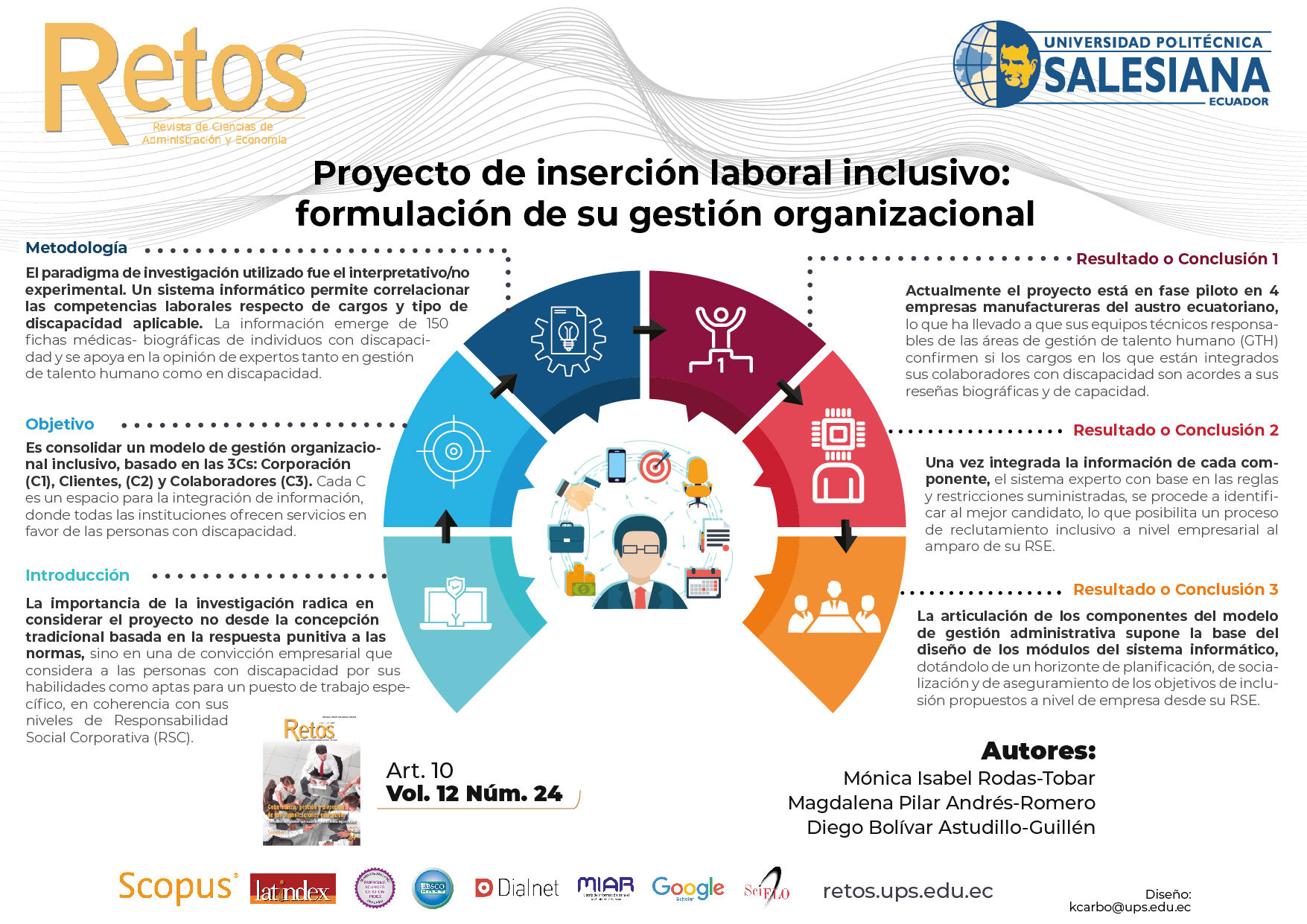Inclusive labor insertion project: formulation of its organizational management
Main Article Content
Abstract
Article Details

This work is licensed under a Creative Commons Attribution-NonCommercial-ShareAlike 4.0 International License.
Authorship: The list of authors signing must include only those people who have contributed intellectually to the development of the work. Collaboration in the collection of data is not, by itself, a sufficient criterion of authorship. "Retos" declines any responsibility for possible conflicts arising from the authorship of the works that are published.
Copyright: The Salesian Polytechnic University preserves the copyrights of the published articles, and favors and allows their reuse under the Creative Commons Attribution-NonCommercial-ShareAlike 3.0 Ecuador license. They may be copied, used, disseminated, transmitted and publicly displayed, provided that: i) the authorship and the original source of their publication (journal, editorial and work URL) are cited; (Ii) are not used for commercial purposes; Iii) mention the existence and specifications of this license.
References
Alles, M. A. (2007). Desempeño por competencias: evaluación de 360o. Ediciones Granica SA.
Azpurúa, G. (2005). La Escuela de Chicago. Sus aportes para la investigación en ciencias sociales. Sapiens. Revista universitaria de investigación, 6(2), 25-35.
Burgardt, A. (2004). El aporte de Max Weber a la constitución del paradigma interpretativo en ciencias sociales. VI Jornadas de Sociología. http://cdsa. aacademica. org/000-045/506. pdf.
Cecchini, S. (2005). Indicadores sociales en América Latina y el Caribe. Cepal.
Colmenares E, A. M. (2012). Investigación-acción participativa: una metodología integradora del conocimiento y la acción. Voces y Silencios. Revista Latinoamericana de Educación, 3(1), 102-115.
CONADIS, R. E. (2019). https://www.consejodiscapacidades.gob.ec/. Obtenido de https://www.consejodiscapacidades.gob.ec/: https://www.consejodiscapacidades.gob.ec/estadisticas-de-discapacidad/
Constitución de la República del Ecuador. (2018). Constitución de la República del Ecuador. Quito.
Del Val Román, J. L. (2016, March). Industria 4.0: la transformación digital de la industria. In Valencia: Conferencia de Directores y Decanos de Ingeniería Informática, Informes CODDII.
Figueroa, G; Paladines, P; Paladines, J; Caicedo, C; Romero, M. (2017). Modelo de plan estratégico de sistemas para la gestión y organización a través de una plataforma informática (Vol. 1). 3Ciencias.
Garcia, E., Orlando, J., & Calle, J. (2017). Inclusion laboral para personas con discapacidad. SINAPSIS.
González Monteagudo, J. (2001). El paradigma interpretativo en la investigación social y educativa: nuevas respuestas para viejos interrogantes. Cuestiones pedagógicas, 15, 227-246.
González-Arias, K., Gálvez-Quezada, J., Robles-Bykbaev, V., Bermeo-Zambrano, F., & León-Pesántez, A. (2021, March). An intelligent decision support system for educational inclusion of children with disabilities: an approximation for multidisciplinary teams. In 2021 IEEE World Conference on Engineering Education (EDUNINE) (pp. 1-6). IEEE.
Guba, E. G. (1965). Methodological Strategies for Educational Change. ERIC.
Ministerio de Relaciones Labores-CONADIS. (2013). Ministerio del Trabajo. Obtenido de http://www.trabajo.gob.ec/wp-content/uploads/downloads/2013/12/MANUALFIN.pdf
Ministerio del Trabajo. (30 de noviembre de 2017). Suin-juriscol. Obtenido de Suin-juriscol: http://www.suin-juriscol.gov.co/viewDocument.asp?ruta=Decretos/30034338
Mintzberg, H. (1988). Cómo modelar la estrategia. Harvard Deusto business review, (34), 73-84.
Norma SAI SA8000®: 2001
Ohmae, K. (1990). La mente del estratega.
Siles González, J. (2012). Investigación cualitativa y enfermería: una perspectiva epistemológica. Investigación Cualitativa en Ciencias de la Salud.
Steiner, G. (1998). Planificación estratégica, lo que todo director debe saber. En Steiner, G., Planificación estratégica, lo que todo director debe saber. CECSA.
WEBER, Max. “Ensayo sobre metodología sociológica”. Amorrortu editores, 3era reimpresión, 1990. Buenos Aires.
Zarate, R; Rodriguez, D. (2014). Los derechos de las personas en situación de discapacidad: Una respuesta desde la responsabilidad social. Revista Eleuthera, 10, 38-57. https://www.redalyc.org/pdf/5859/585961839004.pdf

